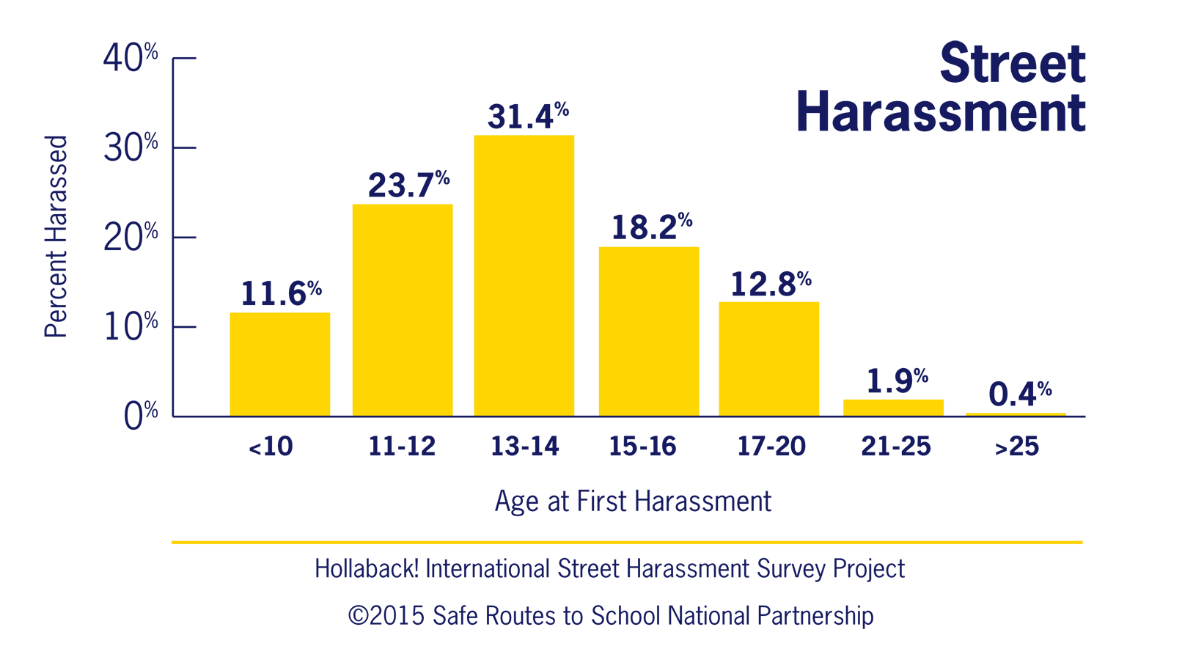Street Harassment Is an Overlooked Barrier to Walking, Biking, and Physical Activity
Everyone should have the opportunity to walk, bike, and be physically active in their community. When we talk about barriers to walking and biking, we often think about elements of the physical environment that make walking and biking dangerous, like speeding cars, missing sidewalks and bike paths, and unsafe street crossings.
There are also other barriers to safe walking and biking that go beyond infrastructure and traffic. Many people, particularly girls and women, people of color, and the LGTBQ community, are the targets of suggestive or aggressive comments, threats, attacks, and other types of street harassment while walking, biking, and taking transit.
Street harassment—unsolicited, threatening, and/or inappropriate comments or actions made in public spaces that are sexual, racial, homophobic, or gender-based—can have a strong negative effect on people who are trying to get around on foot, by bicycle, or on public transit. This type of harassment often peaks for youth during the years that they are likely to be walking, biking, or getting to school on their own without an adult.

The recent rise in anti-immigrant messages and the threat of being harassed or taken into custody by immigration officials has also made it even more difficult for many teens and adults to get around on foot or by bicycle. Immigrants and people of color, regardless of their immigration status, may feel that walking, biking, or simply being in public puts them and their families at increased risk of harassment and harm.
For Safe Routes to School practitioners, advocates, and organizations working to encourage students to walk or bike, it’s important to understand that harassment and bullying can be just as severe an obstacle to active transportation as physical or environmental barriers are. We also need to understand our role in preventing street harassment or addressing it when we see it.
 Fortunately, Safe Routes to School programs offer opportunities to address the issue of street harassment while welcoming people of all races, ethnicities, abilities, and gender identities into a supportive, inclusive, and safe environment. One way to start is with the “safety in numbers” concept: people who are reluctant to walk or bike alone may feel more comfortable walking or biking with others. For those with younger children, joining a walking school bus or bike train program may be key. Resources like our Walking School Bus Toolkit can help parents and educators create a program from scratch or strengthen an existing one.
Fortunately, Safe Routes to School programs offer opportunities to address the issue of street harassment while welcoming people of all races, ethnicities, abilities, and gender identities into a supportive, inclusive, and safe environment. One way to start is with the “safety in numbers” concept: people who are reluctant to walk or bike alone may feel more comfortable walking or biking with others. For those with younger children, joining a walking school bus or bike train program may be key. Resources like our Walking School Bus Toolkit can help parents and educators create a program from scratch or strengthen an existing one.
In addition, Safe Routes to School programs can use the following approaches to incorporate anti-harassment strategies to assist students who may be experiencing harassment and address and prevent harassment from occurring on the way to and from school.
- Provide training and anti-harassment workshops for students as well as adult leaders and personnel. For students, trainings should be age-appropriate and consider the experience of students who are harassed, as well as bystanders and those who are doing the harassing. For adults who are walking school bus leaders or other Safe Routes to School volunteers, workshops should teach them how to address street harassment if they encounter it while walking with students.
- Create public relations campaigns to let people know that harassing students on their way to school is unacceptable. Campaigns can be low-budget and student-run or professionally developed and promoted. Campaigns can occur in school buildings, on the streets, on public transit, at parks, or elsewhere. Campaigns can also let people know where to find safe groups and allies who can provide support and safety on the street.
- Consider safety and harassment audits on school routes and in school vicinities. School or Safe Routes to School personnel can work with students to conduct audits or hotspot analyses of areas near schools and on school travel routes.
If you’re interested in getting involved in International Anti-Street Harassment Week, join the National Partnership and Active Living By Design for a #MoveEquity tweetchat on April 5. We will discuss the risks and challenges that street harassment poses as people walk, bike, or take transit to work, school, and other destinations, and how advocates and community members can address street harassment as a barrier to walking and biking.